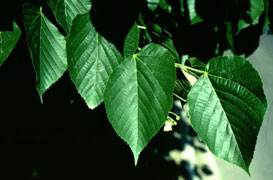


Home
Flowers &
Indoor Plants
Fruits & Nuts
Ornamentals
Vegetables
Special Topics
Resources
Glossary

|
Basswood, American Linden Tilia americana (til-ee-ah ah-mer-ih-can-ah)    Click on thumbnails for larger image. |
 |
What about it? The basswood is a large tree native to North America. Its latin name is thought to come from the Greek word "ptilon" which means feather, and refers to the feathery nature of the seed bracts. Lindens have been admired throughout time for their symmetrical nature and large, heart-shaped leaves. Traditionally, lindens are the trees under which judges sit at the time of sentencing and are also the hiding-place for gnomes and fairies. What is it used for? Basswoods are often used as specimen trees in large gardens and estates. Lindens vary in size, with the basswood being one of the largest. Basswoods prefer deep, rich, moist soils. They are also used in urban environments to line streets, although they are not very tolerant of pollution. Where does it grow? How do we grow it? Basswoods prefer a place in the full sun but will grow in light shade. They are fairly winter tolerant, at least to temperatures around -10 degrees F. Basswoods are not too fussy about their soil conditions either. However, if you notice that spring foliage is slow to sprout and/or the autumn leaves are dropping early, this is a sign that the soil needs improvement Basswoods should be planted 40 feet apart. What are its primary problems? Basswoods sometimes are affected by sooty mold fungus. This fungus grows on the sticky excretions left behind by insects. Anthracnose and leafspots can also afflict basswoods.
© Copyright, Department of Horticulture, Cornell University. |